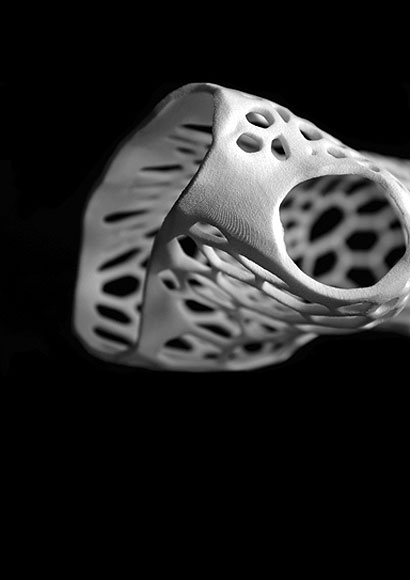|
|
||
|
New Zealander Jake Evill turned a broken arm into a learning experience, redesigning the orthopaedic cast as a digitally devised “exoskeleton” The idea for the Cortex cast came to Jake Evill after he broke his hand. In response to a design brief to improve an existing product, the young designer, a recent graduate of Victoria University of Wellington, New Zealand, decided to build on his recent experience and redesign the orthopaedic cast – with only three months to do it. We accept that a cast will impair our movement because this is crucial to the healing process, but its effect on everyday activities – not to mention the itching, the smell of dead skin cells and palimpsest of scribbles on the dirty plaster of Paris – does little to remind us of its usefulness. Evill’s solution to this problem is an “exoskeleton” that holds the limb in place, but is also washable, ventilated, discreet and recyclable. To do this, he has employed the industrial tool of our times: the 3D printer. Evill’s system, which is still in development, uses a scan of a patient’s limb to produce a 3D model that can be printed in two halves then fastened to the patient. Of the system’s user interface, he says: “You would only set a couple of variables, such as the point of the break, which is determined by an X-ray, and the size and density of the cast, and it would then generate the thickness of the cast, concentrated on the point where the break is.”
Evill modelled the polyamide plastic lattice design on trabecular bone: a porous honeycomb-esque structure, typically found at the end of long bones, with a surface to mass ratio that makes it strong and lightweight. “I just thought nature was the best design,” Evill says. The design also parallels trabecular bone’s growth pattern, as material distribution is weighted towards the most vulnerable areas of a patient’s limb. This emulates the way bone forms wider trabeculae in a denser structure where the bone is most stressed – both natural and synthetic materials are adapted to the body’s requirement. Since he distributed his design online, Evill has been contacted by specialists in rest therapy, sports therapy and veterinary disciplines, which provides some idea of the future uses of his design. For now, Evill is looking into using duel material printers, which can vary the solidity and flexibility of the cast material. “There’s talk of having a more therapy-based cast that would give your wrist movement during the healing process, so once you come out of it, your arm is 100 per cent, as opposed to with a normal cast, where you have muscle atrophy,” Evill says. Although 3D-printing technology is well-established, ideas for its applications are still limited. The technique has already been adopted by the medical field – bio-printing techniques have been used to produce human micro-tissues, which could eventually abolish the need for animal testing. But unlike many of the more experimental 3D-printed creations, the Cortex cast is a wholly tangible prospect: a design for the people, and a strong argument for the technology’s role in the future. |
Words Arthur Thompson |
|
|
||


















